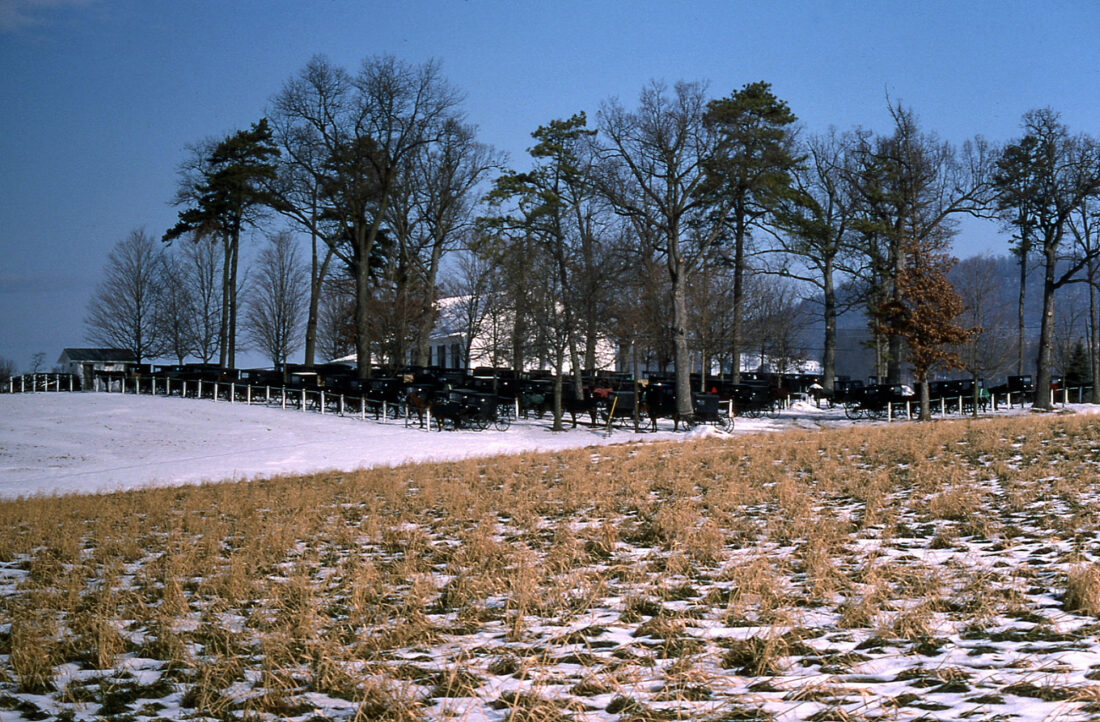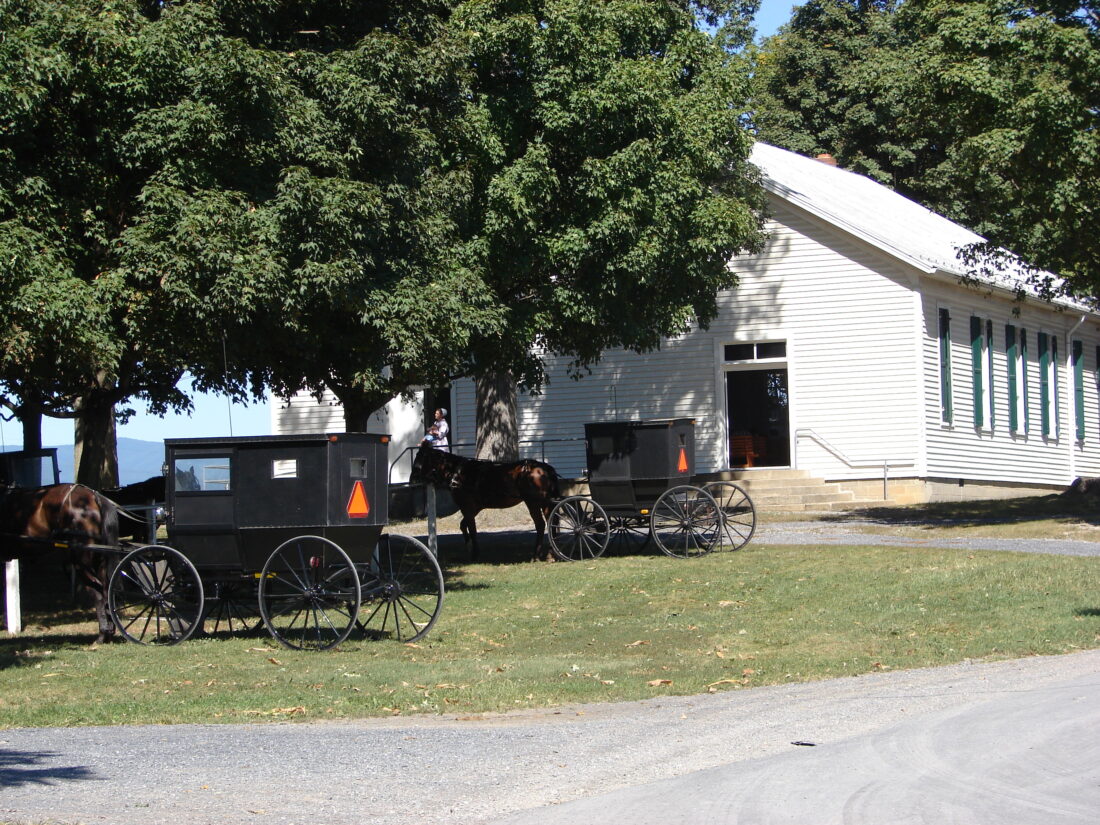by Elwood E. Yoder
I attended the Old Order Mennonite funeral of Lewis G. Martin, a distinguished minister in the Riverdale Conference of Virginia. On a winter’s day, December 27, 2022, I made a journey from my home in Virginia Mennonite Conference to an expression of Anabaptism very different from mine. At Pleasant View Old Order Mennonite Church, Dayton, Virginia, I found common faith in the singing, messages, and relationships I experienced.

We have over fifteen different Mennonite groups in the Shenandoah Valley of Virginia. The cultural differences between my community in the Virginia Mennonite Conference and the Old Order groups in Rockingham County are about as far as the divide stretches. Two Virginia Conference pastors joined me in paying respects to brother Lewis G. Martin (1932-2022). We drove our car around buggies on the way to the funeral, and we slowed down because of the numerous black-clad Old Orders walking to the funeral on a bright mid-winter morning. Buggies with horses tied to hitching posts filled the church lot, line after line of them, so the automobiles parked across the road in a field.
I wanted to pay my respects to Old Order Minister Lewis G. Martin. The ninety-year-old leader in our community, ordained fifty years ago, was widely known and appreciated. I only met Lewis a couple of times, but he often provided information about the Old Order community to former editors of the Shenandoah Mennonite Historian and me. Lewis understood that someone needed to speak from within the Old Order community to Anabaptists beyond and offer details about the group’s size and history. Many buses and van-loads from local educational and cultural groups heard Lewis when they toured the Old Order community. When requested, Lewis took time away from his harness and leather goods shop, his bi-vocational means of making a living, and answered questions about the Old Order communities.
Six years ago, a busload of Mennonites took a tour of the Old Order community in Rockingham County. When we stopped at the Pleasant View Old Order meetinghouse, Lewis G. Martin spoke to us. At eighty-four, Lewis ably interpreted the meaning of the 1901 division in our community from which the Old Orders came. He discussed the late nineteenth-century troubles in Virginia Conference that led to sixty-nine being removed and starting the Virginia Old Orders. Lewis freely shared details about the order of his services, patterns of worship, length of sermons, and singing. I still value the notes I took when our large group listened to Minister Lewis G. Martin share his Anabaptist faith. He patiently answered all our questions.
As I make acquaintances and new friends across Mennonite groups in the Shenandoah Valley, I keep looking for our common Anabaptist faith. At Lewis’ funeral, I found Anabaptist faith in the lyrics and four-part harmonies of songs from a nineteenth-century hymn book placed in a wooden pew rack. Only the words appeared in the little book, but I soon joined the approximately 450 people inside the meetinghouse who were lifting their voices in song to God. Men around me sang the bass part, and I quickly caught on and entered the hymns. The singing was slow, mournful, and reflective of the community’s genuine heartfelt loss of a respected senior minister. The harmonies and theology about eternity gave me time to think about my own frailties and brief time on this planet.
Lewis G. Martin told our tour group that the Virginia Old Orders have fellowship with groups in other states. So, among the four sermons preached during the two-hour funeral service were visiting ministers from Berks County, Pennsylvania, and another minister from an Old Order community in Canada. Both visiting ministers had a Pennsylvania German accent, though they spoke in English at Lewis’ funeral because Virginia Old Order Mennonites speak English. The Riverdale Conference has a group of families who moved to a new settlement in Greenfield, Ohio.
Sitting next to me on the hard wooden slatted bench was a man who held a young son in his lap and another six or seven-year-old son who sat at the end of the bench. Both boys sat quietly, did not have toys to play with, and did not go out during the two-hour service. More importantly, this generous man answered my whispered questions about the Old Orders. There was no program to look at, and no one announced the names of the ministers who spoke, but my new Old Order friend helped me as I scribbled notes. Twice we knelt for long prayers with deep meaning of faith embedded in the minister’s words.
When the service began, I noticed the windows were opened from the outside, allowing a winter’s day breeze to keep the large audience comfortable. Attendees filled every bench. But the windows were opened so the dozens of boys and young men who had no seats and stood outside could listen to the sermons through the windows. With no microphone, it was hard for me to hear inside, and I suspect the fellows outside heard very little. The Pleasant View Order Mennonite meetinghouse has an electric line attached, but it is only used to power the forced-air furnace in the basement. There are no electric lights in the building.
Three years ago, I wrote Lewis G. Martin a letter, asking him about which side of the auditorium the women sit on in the Old Order community. He cordially replied with a handwritten note. Facing the audience from the pulpit, he explained that the women sit on the right, similar to the other Mennonite churches in the Valley during the nineteenth century. Men at the funeral wore plain black coats and black hats. Hooks on the wall all around the interior provided a place to hang them during the service. Looking from the long nineteenth-century style wooden minister’s pulpit, with about ten ordained men seated behind on a raised platform, women and girls sat on the right side of the three-foot wall in the center of the room. They wore funeral black, including their tightly-tied bonnets.
My Anabaptist heritage is Amish-Mennonite, going back eleven generations to the seventeenth-century Amish division in Europe when Yost Yoder chose the Amish side of that split. My parents left the Amish and joined the Conservative Mennonite Conference in 1950, and I joined the Mennonite Church in 1981. I have hundreds of relatives among plain Anabaptist groups in Central America and the United States. So, when I went to Lewis’ funeral, I wanted to pay my respects since I’m on a journey to find common Anabaptist faith among friends and neighbors in the Shenandoah Valley. Lewis generously provided information for my research, writing, and editorial work.
In two years, we will remember and notice the 500th anniversary of the beginning of the Anabaptist movement in Zurich, Switzerland. May we, in our Anabaptist communities, regardless of our chosen practices, find common faith in God, Jesus Christ our Savior, and the illimitable love and charity of the Holy Spirit, which can join us together in Christian unity.
